
The Queen Anne style in British architecture refers to either the English Baroque architectural style that developed around the time of Queen Anne, or a revived form that became popular during the last quarter of the 19th century and the early decades of the 20th century. In other English-speaking parts of the world, Queen Anne style refers to entirely different styles.

Glebe is an inner-western suburb of Sydney. Glebe is located 3 kilometres (1.9 mi) southwest of the Sydney central business district and is part of the local government area of the City of Sydney, in the Inner West region.
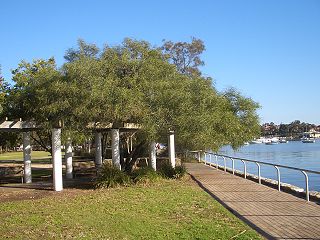
Lilyfield is a suburb in the Inner West of Sydney, in the state of New South Wales, Australia. Lilyfield is located 6 kilometres west of the Sydney central business district, in the local government area of the Inner West Council.

Rozelle is a suburb in the inner west of Sydney, in the state of New South Wales, Australia. It is located 4 kilometres west of the Sydney central business district, in the local government area of the Inner West Council.

The Municipality of Leichhardt was a local government area in the inner-west region of Sydney, New South Wales, Australia. It is about 10 kilometres (6.2 mi) west of the Sydney central business district. On 12 May 2016, Leichhardt merged with Marrickville Council and the Municipality of Ashfield to form the Inner West Council.

The architecture of Sydney, Australia’s oldest city, is not characterised by any one architectural style, but by an extensive juxtaposition of old and new architecture over the city's 200-year history, from its modest beginnings with local materials and lack of international funding to its present-day modernity with an expansive skyline of high rises and skyscrapers.

The Exchange Hotel is a heritage-listed pub located in Balmain, a suburb in the inner west region of Sydney, in the state of New South Wales, Australia.

Australian residential architectural styles have evolved significantly over time, from the early days of structures made from relatively cheap and imported corrugated iron to more sophisticated styles borrowed from other countries, such as the Victorian style from the United Kingdom, the Georgian style from North America and Europe and the Californian bungalow from the United States. A common feature of the Australian home is the use of fencing in front gardens, also common in both the UK and the US.

Annandale is a suburb in the Inner West of Sydney, in the state of New South Wales, Australia. Annandale is located within 5 kilometres west of the Sydney central business district and is part of the local government area of the Inner West Council. Annandale's northern end lies on Rozelle Bay, which is on Sydney Harbour. Glebe lies to its east, Lilyfield and Leichhardt to its west and Stanmore and Camperdown to its south.

The Hunter Baillie Memorial Presbyterian Church is a heritage–listed church of the Presbyterian denomination, located in the inner western Sydney suburb of Annandale, New South Wales, Australia.
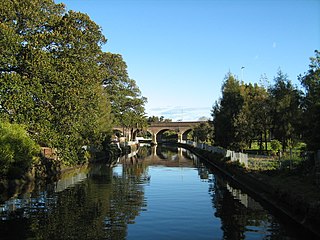
Johnstons Creek, formerly Johnston's Creek, is an urban gully, located in Sydney, Australia and situated in the Leichhardt local government area. The creek flows from Petersham, past Annandale, Camperdown, Forest Lodge and Harold Park, before spilling into Rozelle Bay, within Sydney Harbour.

The Abbey is an historic house located at 272 Johnston Street in the Sydney suburb of Annandale, New South Wales, Australia. The house is listed on the Register of the National Estate, the local government register in the New South Wales Heritage Database, and on the non-statutory register of the National Trust of Australia.
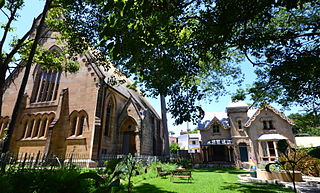
Reussdale is a heritage-listed former private house and now function centre located at 160 Bridge Road in the inner western Sydney suburb of Glebe in the City of Sydney local government area of New South Wales, Australia. It was designed and built by Ferdinand Reuss from 1868 to 1870. It is also known as the former Presbyterian Manse. The property is privately owned. It was added to the New South Wales State Heritage Register on 2 April 1999.

John Young was an Australian bowler, builder, politician and alderman.
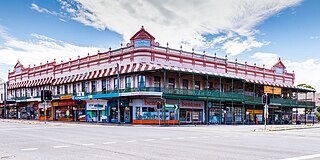
Goodman's Buildings is a heritage-listed retail building at 2-12 Johnston Street, Annandale, Inner West Council, Sydney, New South Wales, Australia. It was added to the New South Wales State Heritage Register on 2 April 1999.

Blyth Terrace is a heritage-listed series of terrace houses located at 82-88 Kent Street, in the inner city Sydney suburb of Millers Point in the City of Sydney local government area of New South Wales, Australia. It was designed by Fowell & McConnel and built by Messrs Hutcherson Bros. It is also known as AMA House. The property was added to the New South Wales State Heritage Register on 2 April 1999.

60-62 Kent Street, Millers Point are heritage-listed terrace houses located at 60-62 Kent Street, in the inner city Sydney suburb of Millers Point in the City of Sydney local government area of New South Wales, Australia. It was added to the New South Wales State Heritage Register on 2 April 1999.

56-58 Kent Street, Millers Point are heritage-listed terrace houses located at 56-58 Kent Street, in the inner city Sydney suburb of Millers Point in the City of Sydney local government area of New South Wales, Australia. The property was added to the New South Wales State Heritage Register on 2 April 1999.

44 Kent Street, Millers Point is a heritage-listed terrace house located at 44 Kent Street, in the inner city Sydney suburb of Millers Point in the City of Sydney local government area of New South Wales, Australia. It was added to the New South Wales State Heritage Register on 2 April 1999.
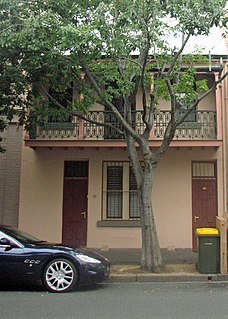
28 Kent Street, Millers Point is a heritage-listed former retail building and now residence located at 28 Kent Street, in the inner city Sydney suburb of Millers Point in the City of Sydney local government area of New South Wales, Australia. The property was added to the New South Wales State Heritage Register on 2 April 1999.
























